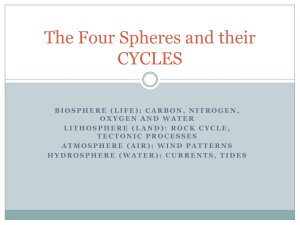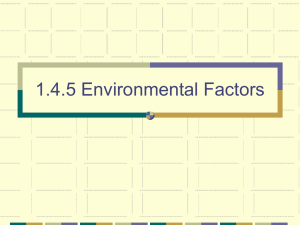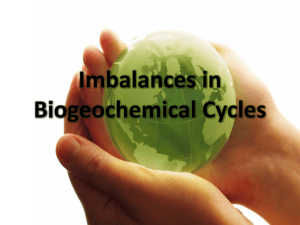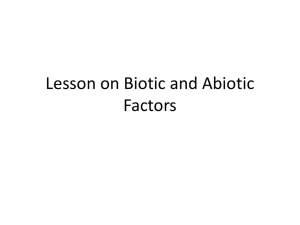The Nonliving Environment
advertisement
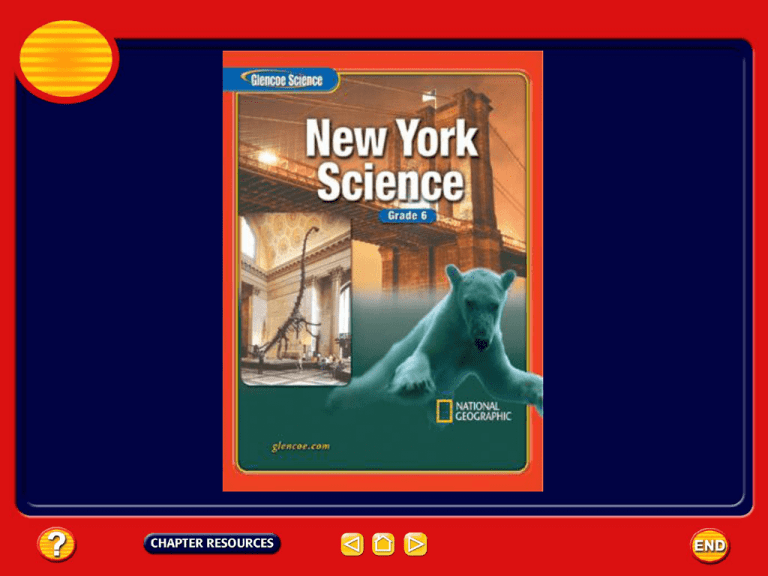
Table of Contents Chapter: The Nonliving Environment Section 1: Abiotic Factors Section 2: Cycles in Nature Section 3: Energy Flow Abiotic Factors 1 Environmental Factors • The features of the environment that are alive, or were once alive, are called biotic (bi AH tihk) factors. • The nonliving, physical features of the environment are called abiotic (ay bi AH tihk) factors. • Abiotic factors include air, water, soil, sunlight, temperature, and climate. Abiotic Factors 1 Air • The air that surrounds Earth is called the atmosphere. • Air contains 78 percent nitrogen, 21 percent oxygen, 0.94 percent argon, 0.03 percent carbon dioxide, and trace amounts of other gases. Abiotic Factors 1 Air • Carbon dioxide (CO2) is required for photosynthesis. • Photosynthesis— a series of chemical reactions—uses CO2, water, and energy from sunlight to produce sugar molecules. • Organisms, like plants, that can use photosynthesis are called producers because they produce their own food. • During photosynthesis, oxygen is released into the atmosphere. Abiotic Factors 1 Air • Cells use oxygen to release the chemical energy stored in sugar molecules. • This process is called respiration. • Through respiration, cells obtain the energy needed for all life processes. Abiotic Factors 1 Water • Water is a major ingredient of the fluid inside the cells of all organisms. • Most organisms are 50 percent to 95 percent water. Abiotic Factors 1 Water • Respiration, digestion, photosynthesis, and many other important life processes can take place only in the presence of water. • Environments that have plenty of water usually support a greater diversity of and a larger number of organisms than environments that have little water. Abiotic Factors 1 Soil • Soil is a mixture of mineral and rock particles, the remains of dead organisms, water, and air. • It is the topmost layer of Earth’s crust, and it supports plant growth. • Soil is formed, in part, of rock that has been broken down into tiny particles. Abiotic Factors 1 Soil • Soil is considered an abiotic factor because most of it is made up of nonliving rock and mineral particles. • However, soil also contains living organisms and the decaying remains of dead organisms. • The decaying matter found in soil is called humus. Click image to view movie. Abiotic Factors 1 Sunlight • Sunlight is the energy source for almost all life on Earth. • During photosynthesis, producers convert light energy into chemical energy that is stored in sugar molecules. • Consumers are organisms that cannot make their own food. • Energy is passed to consumers when they eat producers or other consumers. Abiotic Factors 1 Temperature • Most organisms can survive only if their body temperatures stay within the range of 0°C to 50°C. • Water freezes at 0°C. Abiotic Factors 1 Temperature • The temperature of a region depends in part on the amount of sunlight it receives. • The amount of sunlight depends on the land’s latitude and elevation. Abiotic Factors 1 Latitude • Cities located at latitudes farther from the equator tend to have colder temperatures than cities at latitudes nearer to the equator. Abiotic Factors 1 Latitude • Polar regions receive less of the Sun’s energy than equatorial regions. Near the equator, sunlight strides Earth directly. Near the poles, sunlight strikes Earth at an angle, which spreads the energy over a larger area. Abiotic Factors 1 Elevation • A region’s elevation, or distance above sea level, affects its temperature. • At higher elevations, the atmosphere is thinner than it is at lower elevations. • Air becomes warmer when sunlight heats the air molecules. • Because there are fewer air molecules at higher elevations, air temperatures there tend to be cooler. Abiotic Factors 1 Elevation • Above the timberline—the elevation beyond which trees do not grow—plant life is limited to lowgrowing plants. • The tops of some mountains are so cold that no plants can survive. Abiotic Factors 1 Climate • Climate refers to an area’s average weather conditions over time, including temperature, rainfall or other precipitation, and wind. • Temperature and precipitation are the two most important components of climate. • The average temperature and rainfall in an area influence the type of life found there. Abiotic Factors 1 Wind • Heat energy from the Sun not only determines temperature, nit also is responsible for the wind. • The air is made up of molecules of gas. • As the temperature increases, the molecules spread farther apart. As a result, warm air is lighter than cold air. Abiotic Factors 1 Wind • Colder air sinks below warmer air and pushes it upward. • These motions create air currents that are called wind. Abiotic Factors 1 The Rain Shadow Effect • The presence of mountains can affect rainfall patterns. • Wind blowing toward one side of a mountain is forced upward by the mountain’s shape. • As the air nears the top of the mountain, it cools. • When air cools, the moisture it contains falls as rain or snow. Abiotic Factors 1 The Rain Shadow Effect • By the time the cool air crosses over the top of the mountain, it has lost most of its moisture. • The other side of the mountain range receives much less precipitation. Section Check 1 Question 1 Which is an abiotic factor? A. insects B. plants C. trees D. water Section Check 1 Answer The answer is D. Non-living, physical features of the environment are abiotic. Section Check 1 Question 2 _______ and _______ are the two most important components of climate for the majority of living things. Answer The answer is temperature and precipitation. The average temperature and rainfall in an area influence the type of life found there. Section Check 1 Question 3 Which best describes this illustration? Section Check 1 A. the greenhouse effect B. the nitrogen cycle C. the rain shadow effect D. the water cycle Section Check 1 Answer The answer is C. As wind blows toward one side of the mountain, air is forced upward by the mountain’s shape. The air cools and releases its moisture as rain or snow, losing most of its moisture before reaching the other side of the mountain. Cycles in Nature 2 The Cycles of Matter • The organisms in this closed environment can survive because the materials are recycled. • A constant supply of light energy is the only requirement. • Earth’s biosphere also contains a fixed amount of water, carbon, nitrogen, oxygen, and other materials required for life. Cycles in Nature 2 The Water Cycle • Evaporation takes place when liquid water changes into water vapor, which is a gas, and enters the atmosphere. • Water evaporates from the surfaces of lakes, streams, puddles, and oceans. Cycles in Nature 2 The Water Cycle • Water vapor enters the atmosphere from plant leaves in a process known as transpiration (trans puh RAY shun). • Animals release water vapor into the air when they exhale. • Water also returns to the environment from animal wastes. Cycles in Nature 2 Condensation • The process of changing from a gas to a liquid is called condensation. • Water vapor condenses on particles of dust in the air, forming tiny droplets. • At first, the droplets clump together to form clouds. • When they become large and heavy enough, they fall to the ground as rain or other precipitation. Cycles in Nature 2 Condensation • The water cycle is a model that describes how water moves from the surface of Earth to the atmosphere and back to the surface again. Cycles in Nature 2 Water Use • The amount of water people take from reservoirs, rivers, and lakes for use in households, businesses, agriculture, and power production can reduce the amount of water that evaporates into the atmosphere. Cycles in Nature 2 Water Use • They also can influence how much water returns to the atmosphere by limiting the amount of water available to plants and animals. Cycles in Nature 2 The Nitrogen Cycle • Nitrogen is a necessary ingredient of proteins. • Proteins are required for the life processes that take place in the cells of all organisms. • Nitrogen is also an essential part of the KNA of all organisms. • Although nitrogen is the most plentiful gas in the atmosphere, most organisms cannot use nitrogen directly from the air. Cycles in Nature 2 The Nitrogen Cycle • Plants need nitrogen that has been combined with other elements to form nitrogen compounds. • Through a process called nitrogen fixation, some types of soil bacteria can form the nitrogen compounds that plants need. • Plants absorb these nitrogen compounds through their roots. • Animals obtain the nitrogen they need by eating plants or other animals. Cycles in Nature 2 The Nitrogen Cycle • When dead organisms decay, the nitrogen in their bodies returns to the soil or to the atmosphere. Cycles in Nature 2 The Nitrogen Cycle • The transfer of nitrogen from the atmosphere to the soil, to living organisms, and back to the atmosphere is called the nitrogen cycle. Cycles in Nature 2 Soil Nitrogen • Human activities can affect the part of the nitrogen cycle that takes place in the soil. • If a farmer grows a crop, such as corn or wheat, most of the plant material is taken away when the crop is harvested. • The plants are not left in the field to decay and return their nitrogen compounds to the soil. • If these nitrogen compounds are not replaced, the soil could become infertile. Cycles in Nature 2 Soil Nitrogen • Most fertilizers contain the kinds of nitrogen compounds that plants need for growth. • Fertilizers can be used to replace soil nitrogen in crop fields, lawns, and gardens. • Compost and animal manure also contain nitrogen compounds that plants can use. Cycles in Nature 2 Soil Nitrogen • Another method farmers use to replace soil nitrogen is to grow nitrogen-fixing crops. • Most nitrogen-fixing bacteria live on or in the roots of certain plants, such as peas, clover, beans, and soybeans. • These plants have roots with swollen nodules that contain nitrogen-fixing bacteria. • These bacteria supply nitrogen compounds to the plants and add nitrogen compounds to the soil. Cycles in Nature 2 The Carbon Cycle • Carbon is an important part of soil humus, which is formed when dead organisms decay, and it is found in the atmosphere as carbon dioxide gas (CO2). Cycles in Nature 2 The Carbon Cycle • The carbon cycle describes how carbon molecules move between the living and nonliving world. Cycles in Nature 2 The Carbon Cycle • The carbon cycle begins when producers remove CO2 from the air during photosynthesis. • They use CO2, water, and sunlight to produce energy-rich sugar molecules. • Energy is released from these molecules during respiration. • Respiration uses oxygen and releases CO2. • Photosynthesis uses CO2 and releases oxygen. Section Check 2 Question 1 Which letter corresponds with condensation? A. A B. B C. C D. D Section Check 2 Answer The answer is C. Condensation is the process of changing from a gas to a liquid. Section Check 2 Question 2 _______ is the process by which certain soil bacteria transform nitrogen into the usable nitrogen compounds plants need. A. nitrogen cycle B. nitrogen elimination C. nitrogen fixation D. nitrogenation Section Check 2 Answer The answer is C. The nitrogen cycle is the transfer of nitrogen from the atmosphere to the soil to living organisms, and back to the atmosphere. Section Check 2 Question 3 Which is NOT a means of replacing nitrogen compounds in soil? A. animal manure B. compost C. fertilizers D. planting crops such as corn or wheat Section Check 2 Answer The answer is D. When crops such as wheat and corn are planted, most of the plant is removed when it is harvested. The plants are not left in the field to decay and return their nitrogen compounds to the soil. Energy Flow 3 Converting Energy • Matter and energy move through the natural world in different ways. • Matter can be recycled over and over again. • The recycling of matter requires energy. • Energy is not recycled, but it is converted from one form to another. The conversion of energy is important to all life on Earth. Energy Flow 3 Photosynthesis • During photosynthesis, producers convert light energy into the chemical energy in sugar molecules. • Some of these sugar molecules are broken down as energy. • Others are used to build complex carbohydrate molecules that become part of the producer’s body. • Fats and proteins also contain stored energy. Energy Flow 3 Chemosynthesis • Not all producers rely on light for energy. • During the 1970s, scientists exploring the ocean floor were amazed to find communities at a depth of almost 3.2 km and living in total darkness. • They were found near powerful hydrothermal vents. Energy Flow 3 Hydrothermal Vents • A hydrothermal vent is a deep crack in the ocean floor through which the heat of molten magma can escape. • The water from hydrothermal vents is extremely hot from contact with molten rock that lies deep in Earth’s crust. • Because no sunlight reaches these deep ocean regions, plants or algae cannot grow there. Energy Flow 3 Hydrothermal Vents • Scientists learned that the hot water contains nutrients such as sulfur molecules that bacteria use to produce their own food. • The production of energy-rich nutrient molecules from chemicals is called chemosynthesis (kee moh SHIN thuh sus). Energy Flow 3 Hydrothermal Vents • Consumers living in the hydrothermal vent communities rely on chemosynthetic bacteria for nutrients and energy. • Chemosynthesis and photosynthesis allow producers to make their own energy-rich molecules. Energy Flow 3 Energy Transfer • Energy can be converted from one form to another. It also can be transferred from one organism to another. • Consumers cannot make their own food. Instead, they obtain energy by eating producers or other consumers. Energy Flow 3 Energy Transfer • Organisms can oxidize food to release energy that it can use for maintenance and growth or is transformed into heat. • At the same time, the matter that makes up those molecules is transferred from one organism to another. Energy Flow 3 Food Chains • A food chain is a way of showing how matter and energy pass from one organism to another. • Producers—plants, algae, and other organisms that are capable of photosynthesis or chemosynthesis—are always the first step in a food chain. • Animals that consume producers such as herbivores are the second step. Energy Flow 3 Food Chains • Carnivores and omnivores—animals that eat other consumers—are the third and higher steps of food chains. Energy Flow 3 Food Webs • A forest community includes many feeding relationships. • These relationships can be too complex to show with a food chain. • For example, grizzly bears eat many different organisms, including berries, insects, chipmunks, and fish. Energy Flow 3 Food Webs • Berries are eaten by bears, birds, insects, and other animals. • A bear carcass might be eaten by wolves, birds, or insects. Energy Flow 3 Food Webs • A food web is a model that shows all the possible feeding relationships among the organisms in a community. • A food web is made up of many different food chains. Energy Flow 3 Energy Pyramids • Food chains usually have at least three links, but rarely more than five. • This limit exists because the amount of available energy is reduced as you move from one level to the next in a food chain. • Imagine a grass plant that absorbs energy from the Sun. Energy Flow 3 Energy Pyramids • The plant uses some of this energy to grow and produce seeds. • Some of the energy is stored in the seeds. Energy Flow 3 Available Energy • When a mouse eats grass seeds, energy stored in the seeds is transferred to the mouse. • However, most of the energy the plant absorbed from the Sun was used for the plant’s growth. • The mouse uses energy from the seed for its own life processes, including respiration, digestion, and growth. • Some of this energy was given off as heat. Energy Flow 3 Available Energy • A hawk that eats the mouse obtains even less energy. • The amount of available energy is reduced from one feeding level of a food chain to another. Energy Flow 3 Available Energy • An energy pyramid shows the amount of energy available at each feeding level in an ecosystem. • The bottom of the pyramid, which represents all of the producers, is the first feeding level. Energy Flow 3 Available Energy • It is the largest level because it contains the most energy and the largest number of organisms. Energy Flow 3 Available Energy • As you move up the pyramid, the transfer of energy is less efficient and each level becomes smaller. • Only about ten percent of the energy available at each feeding level of an energy pyramid is transferred to next higher level. Section Check 3 Question 1 All living things are made of _______. Answer The answer is matter. Matter can be recycled over and over again. Section Check 3 Question 2 The production of energy-rich nutrient molecules from chemicals is called _______. Answer The answer is chemosynthesis. Consumers living in hydrothermal vent communities rely on chemosynthetic bacteria for nutrients and energy. Section Check 3 Question 3 Which best describes the level of the energy pyramid with the least energy? A. bottom level B. herbivores C. producers D. top level Section Check 3 Answer The answer is D. As you move up the pyramid, the transfer of energy is less efficient and each level becomes smaller. Carnivores are at the top level of the pyramid. Help To advance to the next item or next page click on any of the following keys: mouse, space bar, enter, down or forward arrow. Click on this icon to return to the table of contents Click on this icon to return to the previous slide Click on this icon to move to the next slide Click on this icon to open the resources file. Click on this icon to go to the end of the presentation. End of Chapter Summary File


